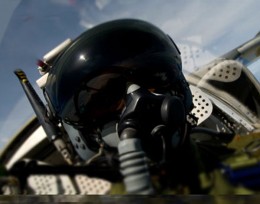
U.S. Air Force aviators will benefit from Wright State-led consortium to research human-performance.
Air Force contracts of up to $6.4 million for research designed to improve human performance in dealing with terrorist threats, combat fatigue and other defense issues have been awarded to Wright State University and a regional consortium of companies.
The Wright State Research Institute-led Human Performance Consortium will conduct the five-year research effort, which will support the mission of the 711th Human Performance Wing and the Air Force Research Lab at Wright-Patterson Air Force Base. The 711th is overseeing the Air Force’s human-performance research, which is moving to Wright-Patterson as a result of the nation’s 2005 base realignment and closure decisions.
“Wright State University is proud to be part of a consortium with expertise in human performance that makes this an attractive place for the Air Force to do this business,” said President David R. Hopkins. “The university is eager to play an increasing role in turning research into technologies that grow businesses and create jobs of the future for the region.”
The consortium, which currently consists of the Wright State Research Institute and a number of area high-tech organizations, was formed to give Air Force a one-stop shop of expertise, equipment and facilities to help it achieve its human-performance objectives.
One contract will enable the consortium to use neuroscience and medical imaging to predict how soldiers will perform under certain conditions and improve that performance.
Consortium members contributing to the neuroscience and medical imaging research include Science Applications International Corp., or SAIC. The other partners are Applied Research Associates and the Kettering Health Network.
“We are pleased to partner in this innovative research,” says Fred Manchur, Kettering Health Network CEO. “The study of human performance can lead to valuable information and understanding in the future of individual health.”
One of the research areas will be investigating how soldiers respond to fatigue.
“Are some people able to power through it? Do some people need a caffeine pill? Within 36 hours do some people need to shut down for 12?” said Ryan Fendley, director of the Wright State Research Institute. “It impacts mission effectiveness. If you’ve got two people on a seven-person team that in the 37th hour need toothpicks to keep their eyes open, you have a problem.”
Another contract involves research into human signatures such as behavior or micro facial expressions that might predict terrorist threats.
The consortium will investigate new techniques and develop new technologies that transform how intelligence and information is processed and analyzed. Researchers at Wright State will develop these techniques and tools, and work with the consortium partners to test the performance with actual operational users in a high-fidelity environment.
Dennis Andersh, SAIC’s Dayton Account Executive, said the research and development planned under the contracts will help revolutionize how new warfighting systems and technology will be developed, implemented and integrated with the operator over the next decade.
“By optimizing human performance solutions that meet increasingly complex mission requirements, reductions in manpower cost, as well as decision making timelines and operator workload can be achieved,” Andersh said. “This research initiative is imperative to help reshape the military’s ability to rapidly and accurately utilize all the human systems’ analysis, engineering and performance tools that are available to the DoD, intelligence and homeland security communities.”
Research in this program will be done by Wright State University, SAIC, ATIC, Radiance Technologies and daytaOhio.
“It really shows the diversity of the region in its expertise. We’ve got organizations that are across the board,” Fendley said. “We all recognize that this is the tip of the iceberg. If this model is successful, we can change the way the region does collaborative research.”

 Wright State University Foundation awards Students First Fund grants
Wright State University Foundation awards Students First Fund grants  Cosmic collection
Cosmic collection  Wright State revives student-faculty collaborative writing journal
Wright State revives student-faculty collaborative writing journal  Fulfilling dreams
Fulfilling dreams  Wright State alumna Nicole Scherzinger wins top British theatre award as star of ‘Sunset Boulevard’
Wright State alumna Nicole Scherzinger wins top British theatre award as star of ‘Sunset Boulevard’ 